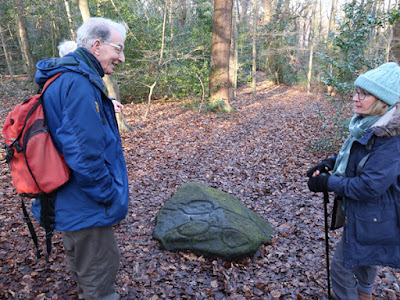 |
| Highly disrupted Rough Rock in the Whinfell Quarry Garden |
In November 2022, I was asked by my friend Linda from the Sheffield U3A Geology Group to go and have a look at the Neolithic rock art in Ecclesall Woods in Sheffield, along with colleagues in an archaeology group that she belongs to – in the hope that I might be able to shine some light on the provenance of the large boulder of sandstone into which the rock art has been carved.
On that occasion, I had concluded that the very coarse grained beds seen in the rock art boulder are typically associated with the Loxley Edge Rock, the Crawshaw Sandstone and the Chatsworth Grit but the Rough Rock, which can be very coarse and pebbly in West Yorkshire, is much finer grained and flaggy around Sheffield.
We nonetheless decided to arrange another meeting in the New Year to look at the Rough Rock in the old quarries at Whirlow and then have a walk down the Limb Brook. A week after I had begun my exploration of Ranmoor, in preparation for my talk to the Ranmoor Society later in the year, I met with Linda and another friend Hilary from the geology group, who had been unable to come on the previous visit to the rock art.
Parking at the crescent at the beginning of the drive up to Whirlow Brook Hall, we firstly had a look at the various alternating beds of fine sandstone and mudstone in the old quarry next to the footpath up the Limb Valley – a very interesting rock exposure that I would like to discuss with an experienced sedimentary geologist.
Moving on to the adjacent Whinfell Quarry Garden, we had a good talk about why certain beds appear to be slumped or folded, which also deserves a better explanation than my experience as a geologist can provide, before having a very quick wander around the lower levels of this old flagstone quarry, where grindstones have been used for a walkway and edging.
Before leaving the garden, I discretely chipped off a couple of pieces of the Rough Rock, which are light brown in colour, fine grained and predominantly constitute quartz, with no degraded iron bearing minerals, feldspar or mica visible.
Crossing the very busy A625 road, we then went to explore the Limb Brook, where further examples of flaggy Rough Rock can be seen in the streambed and stream banks, which has a dip of 4/5 degrees to the south-east.
Blocks of massive sandstone are strewn along the length of the brook, with most of these being inaccessible from the stream bank, but in one place I was able to obtain another specimen of the Rough Rock, which is medium grained and contains a significant amount of degraded iron bearing minerals that give the sandstone a yellowish colour.
Returning to the cars, we stopped at the J.G. Graves Woodland Discovery Centre for lunch before heading off to meet Peter Kennett, a representative of the Sheffield Area Geology Trust. I had already made my own conclusions that the rock art boulder was not from the Rough Rock and could easily have taken my leave at this point, but I was interested to hear what Peter had to say.









No comments:
Post a Comment